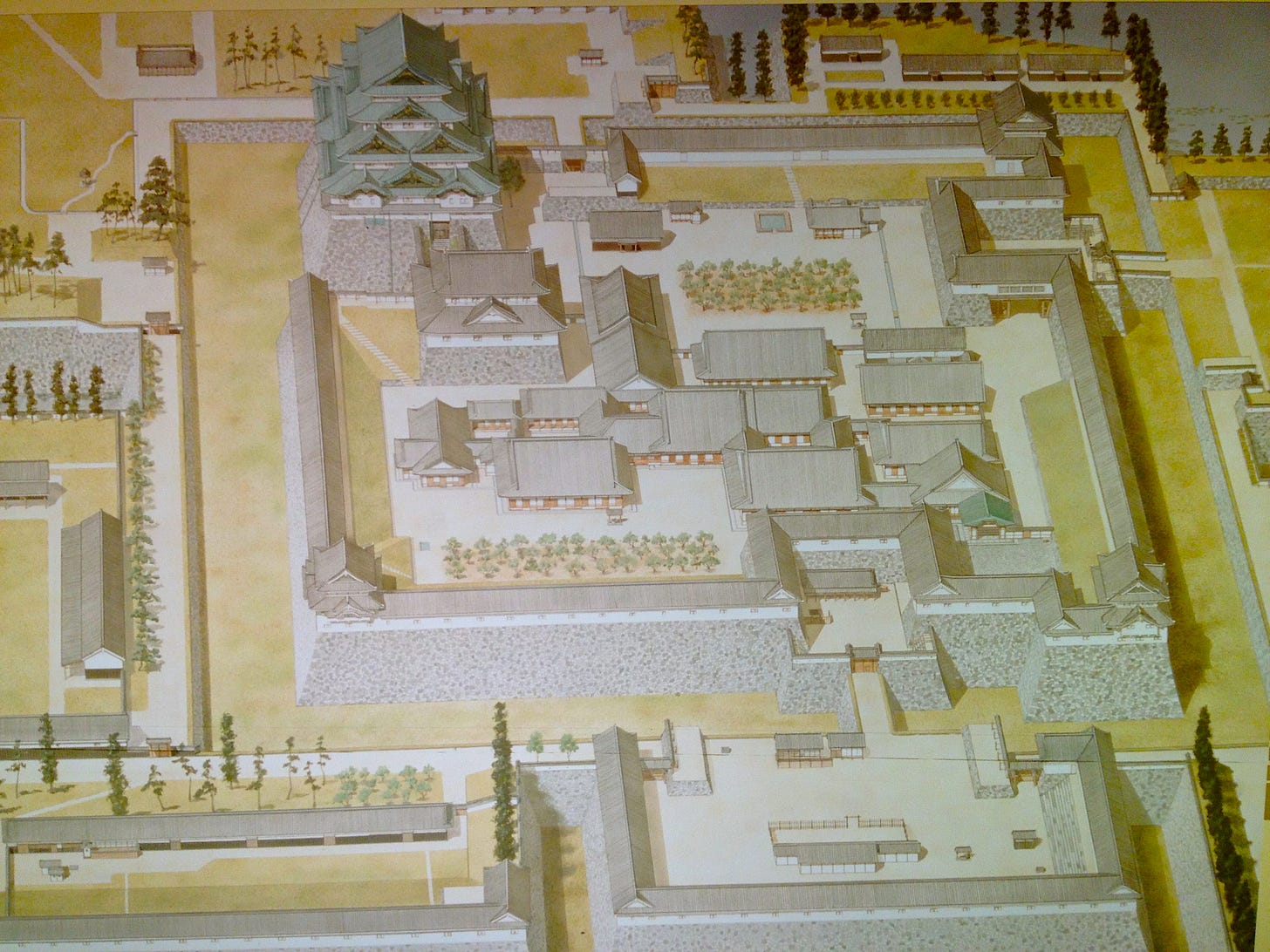Nagoya Castle’s Honmaru Palace. Pt. 1
Samurai-Styled Shoin-Zukuri Architecture at its Finest
Nagoya Castle’s Honmaru Palace was considered the finest example of samurai-styled Shoin-zukuri architecture. Built in 1610 and its interior art works completed a few years later, the palace’s perfection inspired Tokugawa Ieyasu to have something similar built at his Nijo Castle in Kyoto, the Nijo Ni-no-maru Goten, a palace that has survived until modern times and is now both a National Treasure and a World Heritage site. Many of the artworks and design features there, were originally conceived for Nagoya’s Honmaru Palace.
Nagoya’s palace features both Sengoku, civil war period and peace time Edo period architectural traits, and a number of fascinating innovations. The palace consists of 13 structures containing 30 rooms across and area of 3,100m2 and built in three main sections, the Omote Shoin which consisted of the administrative offices of the Lords of Owari Province, the Taimenjo entertainment and living quarters of the lord, and the Jorakuden, accommodation facilities constructed in 1634 solely for the visiting Shogun.
The entire palace was constructed in the samurai preferred Shoin-zukuri style architecture that features a centrally located reception and ceremonial room or hall, separate from the living quarters. Shoin style incorporates an alcove section in which to display treasured items, such as imported Chinese ceramics and hanging scrolls, a secondary display area featuring split-level shelving for smaller ornamental objects, and a recessed niche facing the brightest side of the room was decorative study space where books could be read, and letters written. The Jodan-no-ma, the lord’s main room, was a slightly elevated part of the palace, creating a visual representation of formality and authority.
Nagoya Castle’s imposing keep and the Honmaru Goten Palace were among the first 28 castle structures and works to be made National Treasures in 1930. Unfortunately, the palace, along with most of the extremely well-preserved Nagoya Castle was completely destroyed by WWII aerial fire-bombing. The war ended 3 months later.
From 2009, Nagoya’s Honmaru Palace underwent an authentic rebuild, and the quality of the reproduction is superb! The Honmaru Palace has been restored to a state of perfection using Japanese traditional craftsmen, traditional techniques and authentic materials, recreating the look of the magnificent palace 400 years ago. Only the lord of the castle, the Shogun, the nobility and the elite could enter this world of magnificence and feel the admiration and awe from the breathtaking beauty of the architecture, gilded artworks and fittings.
This was only possible as a wealth of materials regarding Nagoya Castle remain. These included old maps, design sheets, copious photographic evidence, and being the first castle to have been designated a National Treasure meant that everything had been well catalogued, measured, photographed and researched.
First to be restored was the palaces’ Genkan entranceway, reserved for the highest ranked lords and guests only. For that reason, it is only used on special occasions even today. (The palace’s east side Naka-no-kuchibeya entrance is used for standard entry.) The Genkan is characterized by the gracefully curved gabled roof over the Kurumayose, carriage entrance. The black lacquered gables, with gold decorative fittings, topped with a multi-layered roof of 3mm thinly cut Japanese cedar kokera shingles, hammered into place with bamboo nails offers a gentle air to this important castle structure. High ranking lords and visitors could ride their palanquins or horses to this section before dismounting. It has even been suggested that the Shogun’s palanquin could have been carried up the stairs and directly into the heart of the palace alleviating the need for him to walk.
The Ni-no-ma
The Ni-no-ma (Secondary waiting room) is the first room seen on entering the genkan entrance hall. The tatami floored room is quite large and is decorated with paintings of tigers and leopards painted directly onto gold leaf covering. Interestingly, the painters of these fine art pieces had never seen a real tiger or leopard in life. All they had were descriptions from books, and the occasional tiger or leopard skin brought from the Asian continent. The artists imagined the tigers from such scant information in order to paint these imposing animals.
They believed that tigers were the male of the species, and leopards the female, hence seeing tiger and leopard cubs frolicking playfully. They were unaware that the wild cats are different species that don’t even share the same habitats.
Ichi-no-ma
Like the lower ranked Ni-no-ma, the Ichi-no-ma (Primary waiting room) too is decorated with pictures of tigers and leopards. It also has a tokonoma alcove and secondary decorative alcove, establishing it as a room for higher ranked, more important visitors. The wild cats on both the Ni-no-ma and Ichi-no-ma are designed to intimidate visitors waiting for an audience with the lord. Likewise, the use of gold leaf was to show the financial power of the Owari Tokugawa clan.
San-no-ma
Crossing west through the outer corridor, each of the floorboards is an impressive single piece of timber 11m long. On the other side, the elongated San-no-ma room features more art, but gone are the wild animals. In their place are gentle paintings of civets, or musk cats, frolicking among azaleas and various flowers, designed to put the visiting warrior at ease.
Those granted an audience with the Lord, or Shogun would be ushered into the adjoining Ichi-no-ma room, surrounded by gorgeous paintings of cherry blossom and pheasants. Richly symbolic, cherry blossom was associated with the ideals of the samurai and of Buddhism. The impermanence, delicate beauty and short life of the blossom identified with mortality and destiny. Pheasants were auspicious birds, symbols of power, abundance and promise. This room opened into the Jodan-no-ma, the Lord's audience chamber.
Jodan-no-ma
The Lord’s audience chamber, the Jodan-no-ma was the most gorgeous of the initial rooms inside the Honmaru Palace’s Omote Shoin main hall. Raised to impart the authority of the lord, it was built in typical Shoin-zukuri style featuring Zashiki-Kazari ornamental room design, including a recessed writing stall, main focal Tokonoma alcove, and a secondary alcove with split-level shelving. In the case of the Honmaru Palace, all was highly decorated to augment the prestige of the lord. Even the ceiling design and detail is greater here than in any other room.

The main alcove is decorated with a large painting of a sturdy pine tree. In Japanese culture, pine trees are a symbol of strength and power, longevity and virtue. No one besides the castle’s lord or Shogun, his two sword bearers and a handful of guards, and a roju, or clan elder, would be allowed to enter this section. In most cases, those granted an audience would kneel face down towards the tatami mats. The fusuma sliding screens separating the rooms would be slid open from within to reveal the lord of shogun. The roju may say some words on behalf of the lord, and the screens would be slid shut without the guest even laying eyes on his master.
Many of the original paintings displayed in the Honmaru Palace were removed and put into storage towards the end of WWII and so escaped the devastation of fire —but only just! The Nogi Warehouse, originally a Meiji period gunpowder storeroom, was used to house over 1,047 surviving artworks. During the carpet-bombing air raids, a bomb hit the art filled Nogi Warehouse, embedding itself in the roof, but failed to explode. The damage to the roof trusses inside can still be seen to this day. Close analysis of these surviving masterpieces, computer scanning technology, along with over 700 highly detailed glass-plate photographs have helped the classically trained artists of the Aichi Prefectural University of Fine Arts to faithfully recreate the wonderful images, styles and colours of the original Kano School masterpieces.
Part 2 of this series looks at the Taimenjo sections of Nagoya Castle’s Honmaru Goten Palace.














It's truly a marvel. I was glad to see the goten during its reconstruction in 2014 and later when it was finished.